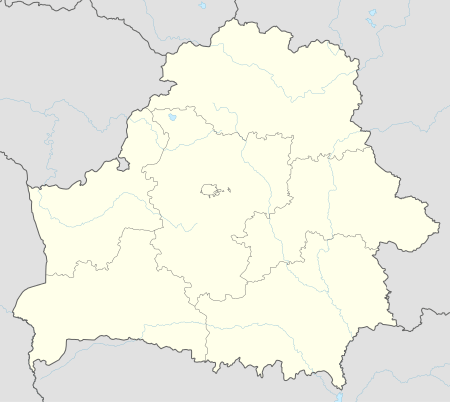Orsha
| Orsha | |||
|---|---|---|---|
| Орша Orša | |||
|
Orša city | |||
| |||
 Orša | |||
| Coordinates: 54°30′33″N 30°25′33″E / 54.50917°N 30.42583°ECoordinates: 54°30′33″N 30°25′33″E / 54.50917°N 30.42583°E | |||
| Country |
| ||
| Voblast | Vitebsk Region | ||
| Raion | Orsha Raion | ||
| Mentioned | 1067 | ||
| Area | |||
| • Total | 38.90 km2 (15.02 sq mi) | ||
| Elevation | 192 m (630 ft) | ||
| Population (2009)[1] | |||
| • Total | 117,225 | ||
| • Density | 3,000/km2 (7,800/sq mi) | ||
| Time zone | EET (UTC+2) | ||
| • Summer (DST) | EEST (UTC+3) | ||
| Postal code | 211030, 211381 - 211394, 211396 - 211398 | ||
| Area code(s) | +375 216 | ||
| License plate | 2 | ||
| Website | Official website | ||
Orša (Belarusian: О́рша, Ворша; Russian: О́рша Russian pronunciation: [ˈorʂə]) is a city in Belarus in Vitebsk Region on the fork of the Dnieper and Arshytsa rivers.
Facts
- Location: 54°28′14″N 30°19′05″E / 54.47056°N 30.31806°E
- Population: 125,000 (est. 2004)
- Phone code: +375 216
- Postal codes: 211030, 211381–211394, 211396–211398
History


Orša was first mentioned in 1067 as Rsha, making it one of the oldest towns in Belarus. The town was named after the river, which was originally also named Rsha, probably from a Baltic root *rus 'slowly flowing.'[2]
In 1320, Orša became a part of the Grand Duchy of Lithuania. In 1398-1407, the Orša castle was built. On September 8, 1514 the famous Battle of Orsha occurred, between allied Grand Duchy of Lithuania with Kingdom of Poland and Muscovite army.[3] Muscovites suffered significant defeat, however victorious Grand Duchy of Lithuania did not fully avail its victory.[3]
In 1555, Mikołaj "Czarny" Radziwiłł founded a Calvinist (Protestant) order in Orša, one of the first in the Belarusian lands. From the sixteenth to eighteenth centuries Orša was a notable religious centre, with dozens of Orthodox, Protestant and Catholic churches and orders. The town was also home to a large Jewish population.[4]
Orša was granted Magdeburg Rights in 1620. In 1630, S. Sobal opened the first printing house at the Kuciejna monastery, which became a well-known centre of Cyrillic-alphabet publishing. The town was damaged during the Russo-Polish War (1654-1667), which was a disaster for Grand Duchy of Lithuania. During the First Polish partition the city was taken over by the Russian Empire in 1772, and became part of the Mogilyov Gubernia. Under Russian rule, it was stripped of its Magdeburg Rights in 1776 and went into cultural and economic decline. The population dropped sharply to just about 2,000 inhabitants. The city symbol in 1781 was changed to one which included the symbol of the Russian empire and five arrows.


In 1812, the city was badly burned during Napoleon's invasion. At the time of Orsha had been taken under control of French troops, there was a French writer Marie-Henri Beyle (also known under the pen name Stendhal) in a rank of intendant.[5] According to the census of 1897, on a total population of 13,161, about 7,000 are Jews.[4] During the First World War, the city was occupied by German forces in February–October 1918. From February 2, 1919, Orša became a part of Homyel region (Vitebsk region, 1920) of Soviet Russia. After the formation of the Soviet Union, it was transferred to the Byelorussian SSR in 1924.
The population before World War II was about 37,000. The city was occupied by Germany on July 16, 1941. The occupiers founded several concentration camps in the city, where an estimated 19,000 people were killed.
There is a widespread Soviet myth of Katyusha Katyusha multiple rocket launcher's maiden attack of July 14, 1941 at Orša, destroying a station with several supply trains. This legend obviously conflicts the fact that Orša remained at the hands of the Soviet Army on July 14 and through July 15, 1941. And even on July 16, 1941 the German troops were unlikely to invade Orša aboard their supply trains. Thus, had the Katyusha’s rockets fallen on any supply trains on July 16, 1941 those would have been the Soviet trains unable to have left Orša railroad station. See Russian Wikipedia's article "Гвардейские реактивные минометы" ("Guards Mortars").
The multiple rocket launchers were top secret in the beginning of World War II and any records of their actions in July 1941 were forbidden, which fact led to numerous rumors and myths. The Soviets encouraged and co-ordinated undercover anti-fascist resistance groups, and one of the most famous was a partisan brigade under the command of Konstantin Zaslonov, operating from the Orša train depot. His group planted ninety-three bombs on German trains in just three months. After March 1942, he went into hiding in the forest, where he and his group continued guerrilla warfare. He was killed in action on 14 November 1942. Soviet troops liberated Orša on 27 June 1944.
Orša was one of the centers of the Belarusian general strike in April 1991. Hundreds of thousands of coal miners had been on strike across the Soviet Union since March 1. On April 3, the day after the central government had imposed consumer price increases, workers at several Minsk factories walked out raising the miners' demand for wages indexed to inflation. Virtually the entire labor force of that city followed on the 4th, joined soon thereafter by strikes across the Belarusian SSR. Mass demonstrations voted for additional demands (including the dissolution of the Union and Belarusian governments and the end of the Communist Party's privileges) and elected delegates from each enterprise to city-wide strike committees, which in turn sent representatives to a central Belarusian Strike Committee (SKB). On April 23, the SKB resumed the general strike after the deadline for its demands to be met had passed. The next morning, Gorbachev, Yeltsin, and leaders of eight of the other Soviet republics published a joint declaration in the papers agreeing to democratic elections for the Soviet parliament and the presidency, a new union treaty that would "radically increase the role of the union republics," and measures to soften the impact of the price increase, but also the introduction of a "special work regime" in many industries.[6]
In response, the Orša strike committee issued a proposal for all local workers to block the railway junction, strategically located on the line linking Moscow and Leningrad to Eastern and Western Europe. This was quickly endorsed by votes to "lie down on the rails" at a citywide meeting at the railway station. On the 25th, the Belarusian authorities concentrated the republic's KGB and riot police forces on Orša, but were resisted by the strikers who sent fuel trains primed to explode down the tracks. Gorbachev mobilized the nearby military forces in Pskov with instructions to restore order over the railway; however many officers declared their refusal to comply, and brigade commander Gennady Sidorov professed a "lack of understanding" of the mission. Meanwhile, workers in other cities throughout Belarus held rallies threatening to retaliate if a drop of blood was shed in Orša. Fearing a clash, and seizing on the government's offer to negotiate with its representatives and grant it radio and air time, the SKB suspended the general strike that evening.[7]
Sports
The bandy club Start has produced players for the Belarus national bandy team.[8][9]
Population change
- 16th-17th century: est. 5,000
- 1776: less than 2,000
- 1939: 37,000
- 1970: 100,000
- 2004: 125,000
Transportation

Orša became an important transportation center after the construction of a Dnieper River port. The coming of railway lines in the second half of the nineteenth century greatly contributed to the city growth:
Today, Orša is a major railway node where the Minsk–Moscow crosses the northern Viciebsk line, which branches south to Mogilev and Kryčaŭ. All trains from Moscow and Saint-Petersburg bound for Western Europe pass through Orša.
The city is also a junction of the important motorways: The M1 (E30) Moscow-Brest and the M8/M20 (E95) Saint Petersburg - Odessa.
Military
OSGOEINT recently reported on the 571st Aircraft Repair Plant (ARP) located at Orša (also called Bolbasovo) Airfield. Accordingly, the 571st ARP repairs Mi-8-17 HIP, Mi-24-35 HIND, as well as the Tu-134 CRUSTY and possibly the IL-76 CANDID. The report goes on to mention recent investment agreements with the Ukraine where private firms plan on providing $12 million to finance facility upgrades during the 2012-2016 period. Press reporting states that the investors plan on building a modern warehouse terminal as well as office buildings for customs services, banking, and a leasing company.[10]
Health problems
Recently, a high rate of oncological diseases attracted attention to this city. Before 1987 there were less than 100 new cancer patients registered each year. Since then the number grew fivefold, with more than 500 new patients registered per year as of 2004. The biggest growth was registered in 2003–04 (178%). This was widely reported in independent media, but Belarusian officials are silent about the alarming health situation and possible reasons for this high cancer rate. Two possible factors mentioned in the independent media are old Soviet military installations in Orša, and the Chernobyl disaster.
Famous natives of Orša
- Polishroots.org Francis Dzierozynski, Jesuit
- Piotra Holub (Golub Petr Semionovich) (1913–1953), artist, author of many well-known Soviet propaganda posters, such as "болтун находка для шпиона" and many others
- Uladzimir Karatkievich, Belarusian writer
- Mikhail Marynich, opposition politician, who was imprisoned in Orša
- Georgy Mondzolevsky, 2-time Olympic volleyball champion
- Gershon Shufman, Hebrew author, known as 'Gimel Shufman'
- Frida Vigdorova, Soviet writer and journalist, famous for writing "White book" after Joseph Brodsky trial, in support of human rights in USSR (ru:Вигдорова, Фрида Абрамовна)
- Lev Vygotsky, psychologist
- Nathan Zarkhi (1900–1935), Soviet playwright and film writer
- Ihar Zhalazoŭski, Olympic medalist speed skater
- Alina Talay, (born 1989), track and field athlete
Sister cities
References
- ↑ "World Gazetteer". Archived from the original on 2013-01-11.
- ↑ E. M. Pospelov, Geograficheskie nazvaniya mira (Moscow, 1998), p. 314.
- 1 2 (Lithuanian) Tomas Baranauskas. Oršos mūšis – didžiausia Lietuvos karinė pergalė prieš Rusiją (Battle of Orša - biggest military victory of Grand Duchy of Lithuania against Russia). Retrieved on 2008-01-18
- 1 2 http://www.jewishencyclopedia.com/articles/11780-orsha
- ↑ (Belarusian) Viktar Korbut. «Галоўная краса горада — манастыры», або Па слядах Стэндаля і Напалеона
- ↑ David Mandel, Perestroika and the Soviet People: Rebirth of the Labour Movement (1991).
- ↑ http://basta-news.net/03041991/
- ↑ http://www.bandy2008.ru/by-z-z-z-z-z-z-z-blr-teamroster-eng.pdf
- ↑ http://www.bandyvm.se/eng2/read.asp?newsID=103
- ↑ Belarus: Orsha's 571st Aircraft Repair Plant Retrieved on 2012-06-06
- ↑ Orša and Spitak became sister cities (in Armenia)
External links
| Wikimedia Commons has media related to Orsha. |
- RUPE "Machine-tool plant "Krasny borets"
- Orsha - city Орша - сити!
- Coat of Arms (GIF file)
- Photos on Radzima.org
- Map of Orsha
- Memories from a childhood in Orsha
- Jewish Encyclopedia
- Орша - город мой! Orsha is my city
- Travel Guide to Orsha



